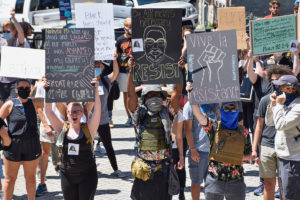
Just weeks after a Nashville police officer admitted in court that his decision to fatally shoot a man was “not reasonably necessary,” the department has unveiled an updated use-of-force policy that emphasizes de-escalation.
The 31-page document reflects demands from last summer’s nationwide protests against police violence and several recent recommendations from the city’s Community Oversight Board and Policing Policy Commission. And it makes it clearer that officers should try other options before punching, kicking or pulling a trigger.
WPLN News compared the old and new policies to see what changes were made. Here are some of the most notable revisions:
Setting a new tone
 Rachel Iacovone WPLN News
Rachel Iacovone WPLN NewsDemonstrators hold signs, one directly speaking to the Metro Nashville Police Department, during the March For Justice in June 2020.
When thousands of people poured into the streets of downtown last summer to protest police brutality, then-Chief Steve Anderson pledged to “tear down the fences” between the department and community members who had lost trust. But, at the time, the Metro Nashville Police Department’s use-of-force policy made no mention of terms like “duty to intervene” or other reforms that protesters were demanding.
The new policy sets a different tone starting on the first page. It instructs officers to use force only when it’s “necessary and reasonable.” And that the force should not violate anyone’s civil rights.
The new introduction encourages officers to use “non-confrontational verbal skills, empathy, and/or active listening” when they encounter someone in crisis and when they need to control a situation to make an arrest or keep people safe. Using force in a “reasonable manner,” the department says, is in the public interest.
“Officers who use excessive or unjustified force degrade the confidence of the community that they serve, undermine the legitimacy of a police officer’s authority, and hinder the Department’s ability to provide effective law enforcement services to the community.”
When is force appropriate?
Most professions don’t allow workers to swing batons, spray Mace or shoot a Taser. Police are granted special powers to use violence to do their jobs — that is, as long as the violence is considered “justified.” And whether it’s justified depends on the parameters laid out in a department’s use-of-force policy.
The types of force allowed — or not explicitly banned — in the old use-of-force policy didn’t always square with what community members considered to be reasonable. For instance, activists and researchers criticized the department for not requiring officers to try safer methods before resorting to violence.
The updated policy includes new instructions about when it’s OK for an officer to use force and cites the seminal 1989 Graham v. Connor U.S. Supreme Court case that lays out when it’s reasonable.
 Courtesy Metro Nashville Police Department
Courtesy Metro Nashville Police Department The Nashville police department’s new use of force policy describes 13 factors officers should consider to determine if use of force is reasonable.
It also lists 13 factors that officers should consider before using force. Those include whether it’s feasible to use de-escalation tactics or another alternative, the seriousness of the crime the person may have committed and whether the person poses an immediate threat to the officer or others.
New language has been added to prohibit officers from using force “solely because another officer is,” as punishment or for retaliation. It also requires officers to intervene if they see another member of the department violating the law or police policy.
This so-called “Duty to Intervene” has recently been implemented at departments across the country as part of the #8cantwait campaign, which urged police to make eight changes last year, following the killing of George Floyd. MNPD introduced a new training about the duty to intervene last June. Now, it’s officially part of policy.
Another addition from the #8cantwait list is a new section about de-escalation. Officers were already encouraged in their training to try other ways to defuse situations before resorting to violence, but they were not explicitly instructed to do so in the use-of-force policy.
The Community Oversight Board urged the department to require de-escalation in a policy advisory report last summer. So did the mayor’s Policing Policy Commission , which released its own set of recommendations last fall. Now, the manual says employees “shall” use de-escalation techniques when “feasible” and that they should “continually assess the situation” to see if they can use those techniques instead of force.
The policy lists multiple de-escalation techniques, including verbal persuasion, moving to a safer distance, deep breathing and avoiding unnecessary displays of weapons. But it tells officers that they can use these techniques only if whoever they are interacting with is willing to cooperate.
“Cooperation is more likely obtained by conveying respect and professionalism to the subject throughout the contact,” the policy states.
More explicit prohibitions
Other changes to the policy add clarity to explicitly ban certain uses of force.
Employees are now prohibited from intentionally hitting someone’s head, neck or throat with an impact device, like a baton, unless it’s a situation when they would be justified to use deadly force. In other words, officers should strike someone in the throat only if they believe they or someone else could immediately be killed. And they should be prepared for that action to potentially cause someone else’s death.
In following with #8cantwait and the Community Oversight Board’s recommendations, the department has prohibited officers from shooting at or from a moving car, motorcycle or bike “unless absolutely necessary” to protect someone’s life.
 Alexis Marshall WPLN News
Alexis Marshall WPLN NewsA protester at the March for Justice in June of 2020 stands in front of the Capitol building to oppose racism and police brutality.
And in response to another board recommendation, MNPD has also explicitly banned neck restraints. The technique was already barred by state law and was not taught at the academy. But it hadn’t been addressed in depth in the manual.
Officers are now prohibited from restraining someone on their stomachs, as George Floyd was, for “any longer than necessary.” If a person has to be placed in the prone position, officers are supposed to reposition them in a way that allows them to breathe better as soon as they’ve been “properly secured.”
Some other new language bars officers from using deadly force to prevent someone from harming him or herself. If there’s no threat to police or other members of the public, deadly force is not allowed. This addition is particularly timely, given that three people have shot themselves during encounters with Nashville police this year. In two situations, officers didn’t fire their weapons. But, in one instance, the man suffered wounds from both his own gun and an officer’s. A medical examiner was unable to determine which bullet killed him, according to The Tennessean.
One additional notable change is that employees are now not only required to administer first aid if someone is injured, but to do so “as quickly as reasonably possible.”
Looking for patterns
The updated policy doesn’t just change how police will be instructed to use force. It also modifies the department’s process for reviewing officers’ actions.
MNPD already had a tracking system in place, which required officers to fill out a form any time they use any type of force – even just holding their Taser without discharging it. But now, the policy more clearly defines each kind of force that must be documented. It also requires officers to report new details, like when someone in custody complains of a self-inflicted injury or pain from handcuffs.
Plus, the new policy sets clearer guidance for the department’s annual use-of-force data analysis. It will now include demographic patterns about who has been subjected to force and how data trends have impacted additional changes to use of force protocols, equipment and training.
Those reports will be shared with the chief of police and the Force Review Board, which decides whether officers’ uses of force are within policy. (The policy doesn’t specify if the reports will also be shared with the public). A representative from the civilian-run police oversight agency is also now guaranteed a seat on the board, so that police, alone, won’t be policing their uses of force in the future.
 This story was produced as part of APM Reports’ public media accountability initiative, which supports investigative reporting at local media outlets around the country. Support also came from the Corporation for Public Broadcasting.
This story was produced as part of APM Reports’ public media accountability initiative, which supports investigative reporting at local media outlets around the country. Support also came from the Corporation for Public Broadcasting.


